Latam Airlines Bundle
How Did Latam Airlines Take Flight?
In 2012, the skies of Latin America witnessed a historic transformation as LAN Airlines and TAM Airlines joined forces, giving rise to Latam Airlines SWOT Analysis. This merger reshaped the aviation landscape, creating the largest airline group in the region. This remarkable journey, driven by strategic vision, has connected the diverse continent with the rest of the world.
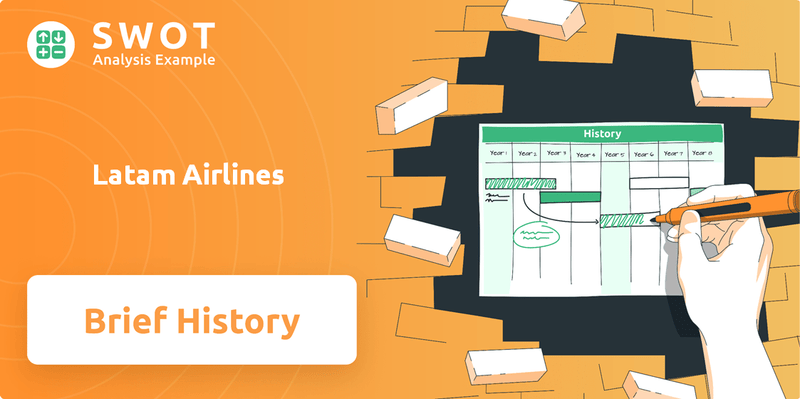
The Latam Airlines story is a compelling narrative of growth and adaptation within the airline history. From its Latam Airlines origins and development, the company has navigated numerous challenges, including economic fluctuations and fierce competition. Understanding the Latam history provides crucial insights into the evolution of South American airlines and the broader impact of aviation in Latin America, highlighting key milestones and strategic decisions.
What is the Latam Airlines Founding Story?
The story of Latam Airlines Group is a tale of two airlines, LAN Airlines and TAM Airlines, merging to form one of the largest airline groups in Latin America. This journey began with the individual histories of these airlines, each with its own unique origin and development. The formation of Latam Airlines represents a significant chapter in the history of aviation in South America.
The roots of the Latam Airlines can be traced back to the early 20th century. The airline's story highlights the evolution of air travel in the region, from its inception to its current status. This history is marked by key milestones, mergers, and expansions that have shaped the airline into what it is today.
Understanding the Latam history requires looking at the origins of its founding airlines. These airlines, each with their own legacies, played crucial roles in connecting different parts of Latin America. The merger of these airlines was a pivotal moment, creating a powerhouse in the aviation industry.
LAN Airlines was established in 1929 in Chile as LAN Chile by Commander Arturo Merino Benítez. TAM Airlines began in Brazil in 1961 as Transportes Aéreos Marília.
- LAN Airlines was founded with the goal of connecting Chile's regions and expanding across Latin America.
- TAM Airlines started as an air taxi service, serving the agricultural frontier of Brazil.
- Both airlines aimed to overcome geographical barriers and foster connectivity in Latin America.
- The initial funding for LAN likely came from government support and private investment.
LAN Airlines, the precursor to Latam Airlines, was founded in 1929 in Chile as LAN Chile. Commander Arturo Merino Benítez envisioned a national airline to connect the diverse regions of Chile and eventually expand throughout Latin America. This vision was supported by government backing and private investment, reflecting the strategic importance of air travel during that period. The airline's initial focus was on providing essential air transportation services for passengers and cargo within Chile. LAN's early operations were crucial in developing air travel infrastructure in the region.
In contrast, TAM Airlines emerged in Brazil in 1961 as Transportes Aéreos Marília. Founded by five airline pilots, including Orlando Ometto, TAM initially offered air taxi services. Their focus was on the rapidly developing interior of Brazil, where ground transportation was often challenging. The name 'TAM' derived from 'Táxi Aéreo Marília,' reflecting its origins. TAM's business model centered on providing reliable air links for business and leisure travelers in underserved areas. This approach allowed TAM to establish a strong presence in Brazil's aviation sector.
Both airlines, born in different contexts, shared a common goal: to leverage air travel to overcome geographical barriers and promote connectivity within Latin America. These individual histories are essential to understanding the eventual merger that formed Latam Airlines Group. For more insights into the ownership structure, you can read about the Owners & Shareholders of Latam Airlines.
Latam Airlines SWOT Analysis
- Complete SWOT Breakdown
- Fully Customizable
- Editable in Excel & Word
- Professional Formatting
- Investor-Ready Format
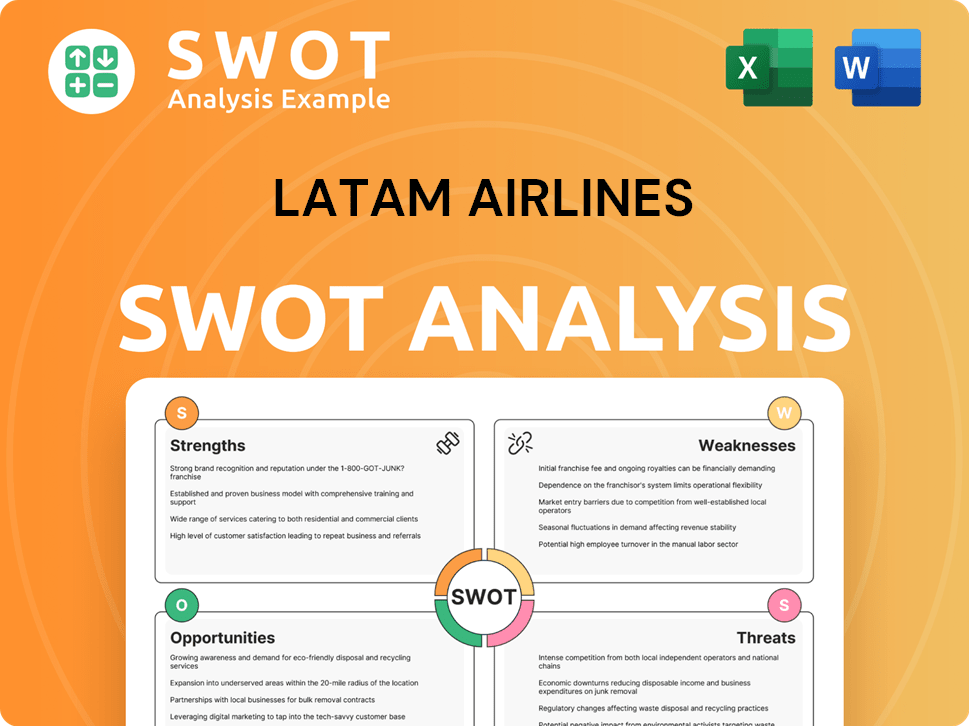
What Drove the Early Growth of Latam Airlines?
The early growth and expansion of the Latam Airlines involved distinct strategies for its founding airlines, LAN and TAM. LAN Airlines, established in 1929, focused on domestic growth in Chile before international expansion. TAM Airlines, founded in 1961, concentrated on the Brazilian domestic market, eventually becoming a major player. Both airlines adapted to evolving competition, prioritizing customer service and operational efficiency.
LAN Airlines began its journey with domestic routes within Chile. In the late 20th century, it expanded internationally, reaching other South American countries, North America, and Europe. The privatization of LAN in the late 1980s and early 1990s provided capital for further expansion. Strategic alliances and codeshare agreements extended its reach.
TAM Airlines initially concentrated on the Brazilian domestic market, particularly regional air transport. As the Brazilian economy grew, TAM expanded its fleet and network. The company began international flights in the late 1990s and early 2000s. Acquisitions of smaller Brazilian airlines helped consolidate its market share.
Both LAN and TAM faced competitive landscapes in their respective markets. They focused on customer service, network optimization, and operational efficiency. These strategies helped secure their positions as leading carriers in their regions. The privatization of LAN was a significant event.
LAN modernized its fleet with more advanced aircraft. TAM expanded its network through acquisitions and organic growth. Route expansion was a key focus for both airlines. These efforts allowed them to serve more destinations and increase their passenger capacity.
Latam Airlines PESTLE Analysis
- Covers All 6 PESTLE Categories
- No Research Needed – Save Hours of Work
- Built by Experts, Trusted by Consultants
- Instant Download, Ready to Use
- 100% Editable, Fully Customizable
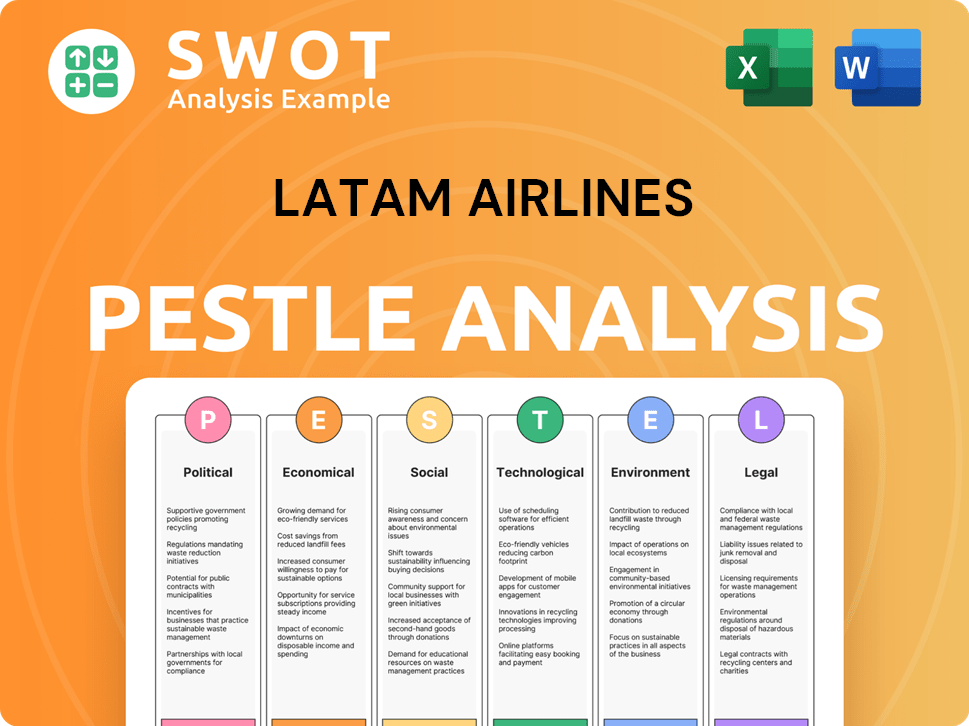
What are the key Milestones in Latam Airlines history?
The Latam Airlines story, from its inception to its current form, is marked by significant milestones that have shaped its identity and operational strategies. Initially, the individual airlines, LAN and TAM, had their own distinct strengths and legacies within the aviation industry. The merger of these two entities in 2012 was a pivotal moment, creating a unified airline group with a broader network and enhanced operational capabilities. This consolidation aimed to enhance competitiveness and provide a more comprehensive travel experience across Latin America and beyond.
| Year | Milestone |
|---|---|
| 2012 | Merger of LAN Airlines and TAM Linhas Aéreas, forming LATAM Airlines Group, creating one of the largest airline groups in Latin America. |
| 2016 | LATAM Airlines Group implemented a new brand identity, unifying the branding across all its subsidiaries. |
| 2020 | LATAM Airlines Group filed for Chapter 11 bankruptcy protection in the United States due to the COVID-19 pandemic's impact on air travel. |
| 2022 | LATAM Airlines Group successfully completed its Chapter 11 restructuring process, emerging from bankruptcy. |
Post-merger, LATAM has focused on innovation in digital services and enhancing the customer experience. The company has invested in modernizing its fleet with more fuel-efficient aircraft, aligning with global sustainability trends. These efforts include the implementation of new technologies to streamline operations and improve passenger services.
LATAM has been actively renewing its fleet with newer, more fuel-efficient aircraft, such as the Airbus A320neo family and Boeing 787 Dreamliner. This modernization reduces fuel consumption and emissions.
The airline has invested in digital platforms to improve the customer experience, including online booking systems, mobile apps, and self-service tools. This enhances convenience and efficiency for passengers.
LATAM has upgraded its in-flight entertainment systems, offering a wider selection of movies, TV shows, and music. This improves the overall passenger experience during flights.
LATAM has implemented various sustainability initiatives, including fuel efficiency programs and waste reduction strategies. This supports the company's commitment to environmental responsibility.
The airline continually optimizes its route network to improve efficiency and connectivity. This includes adjusting flight schedules and adding new destinations to meet market demands.
LATAM has focused on improving customer service through better training for employees and the implementation of customer feedback systems. This ensures a more positive travel experience.
The
Fluctuations in economic conditions within Latin American countries have affected demand and profitability. Currency devaluations and inflation rates have impacted operating costs and revenues.
The airline faces strong competition from both established carriers and low-cost airlines. This competition puts pressure on pricing and market share.
The COVID-19 pandemic caused a dramatic decrease in air travel demand, resulting in significant financial losses. This led to the Chapter 11 bankruptcy filing in 2020.
The company has had to restructure its operations to adapt to changing market conditions. This includes route adjustments, fleet optimization, and workforce reductions.
Fluctuations in fuel prices have a significant impact on operating costs. The airline must manage fuel hedging strategies to mitigate these risks.
Changes in aviation regulations and international trade policies can affect operations. The company must adapt to new rules regarding safety, environmental standards, and international agreements.
Latam Airlines Business Model Canvas
- Complete 9-Block Business Model Canvas
- Effortlessly Communicate Your Business Strategy
- Investor-Ready BMC Format
- 100% Editable and Customizable
- Clear and Structured Layout
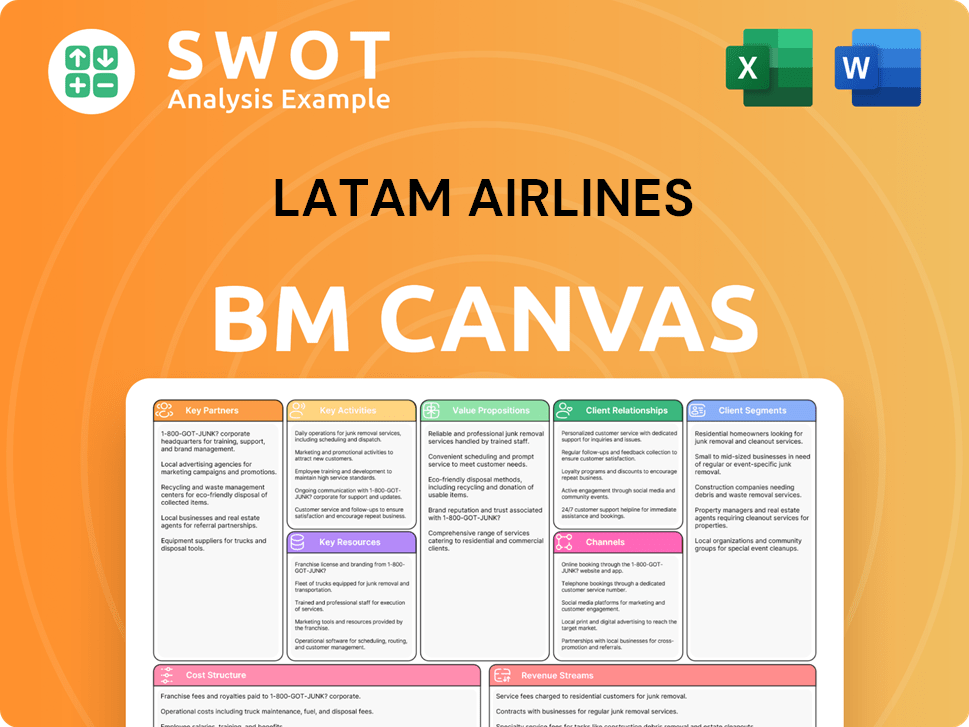
What is the Timeline of Key Events for Latam Airlines?
The Latam Airlines story is marked by significant milestones that have shaped its trajectory. From its origins in the early 20th century to its emergence as a leading airline in Latin America, the company has navigated mergers, economic challenges, and global events to establish its presence in the aviation industry.
| Year | Key Event |
|---|---|
| 1929 | LAN Chile is founded, marking the beginning of the company's presence in the aviation sector. |
| 1961 | Transportes Aéreos Marília (TAM) is established in Brazil, expanding the airline's footprint in South America. |
| 1980s-1990s | LAN undergoes privatization, enabling significant expansion and modernization of its fleet. |
| Late 1990s-Early 2000s | TAM begins its international expansion, increasing its global reach and competitiveness. |
| 2010 | LAN Airlines and TAM Airlines announce their intention to merge, setting the stage for a major consolidation in the aviation industry. |
| 2012 | The merger is completed, forming LATAM Airlines Group S.A., creating one of the largest airline groups in Latin America. |
| 2015 | LATAM introduces its new unified brand identity, streamlining its image and customer experience. |
| 2019 | Delta Air Lines acquires a 20% stake in LATAM, forming a strategic alliance to enhance network reach and customer offerings. |
| 2020 | LATAM Airlines Group files for Chapter 11 bankruptcy protection due to the impact of the COVID-19 pandemic, restructuring its operations. |
| 2022 | LATAM Airlines Group successfully emerges from its Chapter 11 reorganization, reducing its debt and securing new capital. |
| 2023 | LATAM Group announces a net profit of US$2.52 billion, marking its first annual profit since 2019, demonstrating a strong recovery. |
| 2024 | LATAM projects continued growth and financial stability as it navigates the post-pandemic recovery, focusing on strategic initiatives. |
LATAM is focused on optimizing its route network, which involves adjusting flight schedules and destinations to meet evolving travel demands. This includes increasing frequencies on high-demand routes and exploring new destinations to improve connectivity. The goal is to enhance operational efficiency and provide better service to passengers.
Investing in fleet modernization with fuel-efficient aircraft is a key strategy for LATAM. This involves adding new aircraft and retiring older models to reduce fuel consumption and operational costs. The company aims to improve its environmental footprint and enhance the overall passenger experience.
Enhancing the digital customer experience is a priority for LATAM. This includes improving its website and mobile app, offering more personalized services, and streamlining the booking and check-in processes. The aim is to provide passengers with a seamless and convenient travel experience.
The strategic alliance with Delta Air Lines is expected to continue to provide significant benefits. This includes expanded network reach, increased customer offerings, and enhanced operational synergies, particularly for routes between North and South America. This collaboration is crucial for LATAM's long-term growth.
Latam Airlines Porter's Five Forces Analysis
- Covers All 5 Competitive Forces in Detail
- Structured for Consultants, Students, and Founders
- 100% Editable in Microsoft Word & Excel
- Instant Digital Download – Use Immediately
- Compatible with Mac & PC – Fully Unlocked
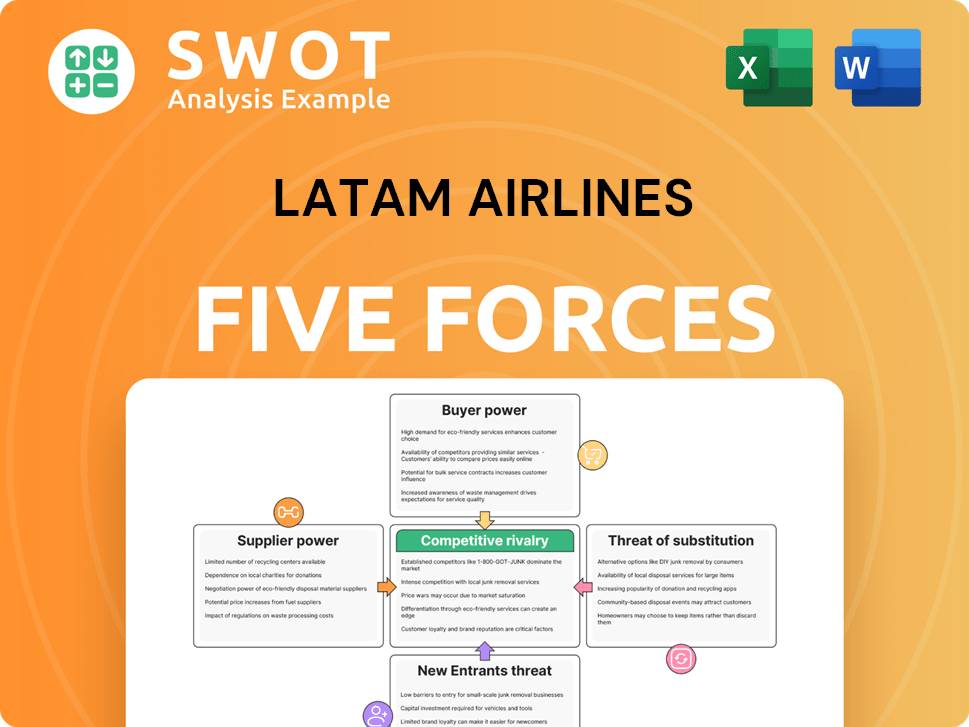
Related Blogs
- What is Competitive Landscape of Latam Airlines Company?
- What is Growth Strategy and Future Prospects of Latam Airlines Company?
- How Does Latam Airlines Company Work?
- What is Sales and Marketing Strategy of Latam Airlines Company?
- What is Brief History of Latam Airlines Company?
- Who Owns Latam Airlines Company?
- What is Customer Demographics and Target Market of Latam Airlines Company?
Disclaimer
All information, articles, and product details provided on this website are for general informational and educational purposes only. We do not claim any ownership over, nor do we intend to infringe upon, any trademarks, copyrights, logos, brand names, or other intellectual property mentioned or depicted on this site. Such intellectual property remains the property of its respective owners, and any references here are made solely for identification or informational purposes, without implying any affiliation, endorsement, or partnership.
We make no representations or warranties, express or implied, regarding the accuracy, completeness, or suitability of any content or products presented. Nothing on this website should be construed as legal, tax, investment, financial, medical, or other professional advice. In addition, no part of this site—including articles or product references—constitutes a solicitation, recommendation, endorsement, advertisement, or offer to buy or sell any securities, franchises, or other financial instruments, particularly in jurisdictions where such activity would be unlawful.
All content is of a general nature and may not address the specific circumstances of any individual or entity. It is not a substitute for professional advice or services. Any actions you take based on the information provided here are strictly at your own risk. You accept full responsibility for any decisions or outcomes arising from your use of this website and agree to release us from any liability in connection with your use of, or reliance upon, the content or products found herein.